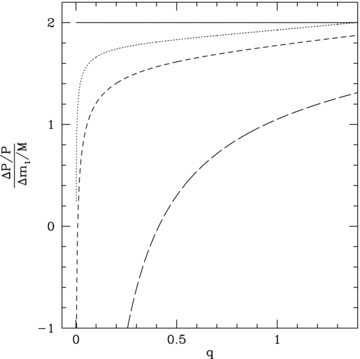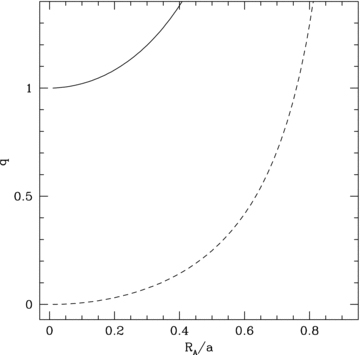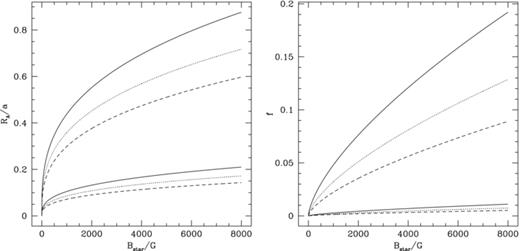-
PDF
- Split View
-
Views
-
Cite
Cite
Rebecca G. Martin, Mario Livio, Bradley E. Schaefer, On orbital period changes in nova outbursts, Monthly Notices of the Royal Astronomical Society, Volume 415, Issue 2, August 2011, Pages 1907–1912, https://doi.org/10.1111/j.1365-2966.2011.18835.x
Close - Share Icon Share
Abstract
We propose a new mechanism that produces an orbital period change during a nova outburst. When the ejected material carries away the specific angular momentum of the white dwarf, the orbital period increases. A magnetic field on the surface of the secondary star forces a fraction of the ejected material to corotate with the star, and hence the binary system. The ejected material thus takes angular momentum from the binary orbit and the orbital period decreases. We show that for sufficiently strong magnetic fields on the surface of the secondary star, the total change to the orbital period could even be negative during a nova outburst, contrary to previous expectations. Accurate determinations of pre- and post-outburst orbital periods of recurrent nova systems could test the new mechanism, in addition to providing meaningful constraints on otherwise difficult to measure physical quantities. We apply our mechanism to outbursts of the recurrent nova U Sco.
1 INTRODUCTION
Classical novae are binary systems in which mass is transferred from a main-sequence star on to a white dwarf by Roche lobe overflow. The critical amount of mass that can be accreted on to the surface of the white dwarf prior to an outburst is a strongly decreasing function of the white dwarf mass (Truran & Livio 1986). At this mass limit, the temperature and density at the base of the accreted layer are high enough for hydrogen to ignite. The temperature then rises rapidly in a thermonuclear runaway (Starrfield, Sparks & Shaviv 1988) and the pressure at the base of the accreted layer becomes high enough that the accreted mass (and sometimes a little more) is ejected (e.g. Kovetz & Prialnik 1985).
Recurrent novae show outbursts at intervals of 10–80 yr (Webbink et al. 1987; Warner 1995). To account for the short time-scale between the outbursts, the white dwarf in a recurrent nova system must have a mass, M1, close to the Chandrasekhar limit (e.g. Kato & Hachisu 1988, 1989). We consider in more detail the recurrent nova U Sco that most recently erupted in 2010. The evolved companion in U Sco has a mass of M2 = 0.88 M⊙ so the mass ratio, q=M2/M1 = 0.64, is relatively large.
In Section 2 we begin by re-examining all the previously proposed sources of orbital period change during a nova outburst. We first describe a simple model where the material carries away its specific angular momentum, then we include mass accretion on to the companion and frictional angular momentum losses as the binary moves through the common envelope. In Section 3 we propose a new mechanism for orbital period change involving the magnetic field on the secondary star. In Section 4 we apply our model to the outbursts in the recurrent nova U Sco.
2 OUTBURST MODEL










The change (ΔP/P)/(Δm1/M) as a function of mass ratio, q=M2/M1. For the solid line the ejected mass just carries away its specific angular momentum (equation 9). The dotted line shows the case where accretion on to the secondary is considered (corresponding separation change in equation 11). The short-dashed line includes accretion on to the secondary and frictional angular momentum losses (corresponding separation change in equation 14). The long-dashed line takes into account the angular momentum change of the ejected material due to a magnetic field on the secondary that has RA = 0.75 a (corresponding separation change in equation 29). We calculate the period change from the separation change with equation (8).
2.1 Mass accretion on to the companion




2.2 Frictional angular momentum losses

 for a very slow nova and x = 1 for a fast nova. We note that Livio, Govarie & Ritter (1991) suggest that assumptions made in deriving this mean that is valid only for novae with longer orbital periods. Again, we can find the period change for this model with equation (8). In Fig. 1 we plot (ΔP/P)/(Δm1/M) as a function of the mass ratio for this model for a slow nova (short-dashed line). The separation change (and hence period change) here is, as expected, less than that for the previous case without the frictional angular momentum losses.
for a very slow nova and x = 1 for a fast nova. We note that Livio, Govarie & Ritter (1991) suggest that assumptions made in deriving this mean that is valid only for novae with longer orbital periods. Again, we can find the period change for this model with equation (8). In Fig. 1 we plot (ΔP/P)/(Δm1/M) as a function of the mass ratio for this model for a slow nova (short-dashed line). The separation change (and hence period change) here is, as expected, less than that for the previous case without the frictional angular momentum losses.2.3 Magnetic braking and gravitational radiation


3 COROTATING EJECTED MATERIAL
In this section we consider an entirely new mechanism that can change the orbital period during a nova outburst. Suppose ejected material that moves within a critical radius (that depends on the magnetic field strength) of the secondary star couples to its magnetic field and so is forced to corotate with the binary orbit. The transfer of angular momentum between the ejected material and the binary orbit causes a change to the orbital period of the system.




 is the mass ejection rate from the primary white dwarf star. We approximate the average mass-loss rate with
is the mass ejection rate from the primary white dwarf star. We approximate the average mass-loss rate with 









The change (ΔP/P)/(Δm1/M) as a function of mass ratio, q. For the solid line the ejected mass carries away only its specific angular momentum. All other lines take into account the angular momentum change of the ejected material due to a magnetic field on the secondary (corresponding separation change in equation 29). In order of decreasing height the lines have RA = 0.25a (dotted line), RA = 0.5a (short-dashed line), RA = 0.75a (long-dashed line) and RA = 0.9a (dot–dashed line).
In Fig. 1 we also plot (ΔP/P)/(Δm1/M) for an Alfvén radius of 0.75a (long-dashed line) for comparison with the other models we have considered. For this strong magnetic field, the period change is smaller than with mass transfer to the secondary or frictional angular momentum losses. If a secondary star has a large magnetic field then it will significantly alter the orbital period change during a nova outburst.


The solid line shows the critical mass ratio, qcrit, as a function of the Alfvén radius. If q < qcrit the period decreases due to the magnetic field, whereas if q > qcrit the period increases. Below the dashed line, the period change becomes negative.
We also plot the dashed line for the mass ratio below which the period change is negative. We see that for the larger magnetic fields it is possible that the orbital period may actually decrease for all mass ratios. This effect could be significant even for larger mass ratios. Frictional angular momentum losses only dominate for q≲ 0.01 (Shara et al. 1986) so this new mechanism potentially has a greater effect on the orbital period change.
4 RECURRENT NOVAE
There are now 10 recurrent novae known in our galaxy (the tenth one was discovered last year; Pagnotta et al. 2009) and one system in the LMC. In this group, U Sco has the fastest decline rate of the light curve in past outbursts, and the shortest recurrence period (11 yr since the last outburst, Schaefer 2001). It has outbursts recorded in 1863, 1906, 1917, 1936, 1945, 1969, 1979, 1987, 1999 (Schmeer 1999; Schaefer 2010) and 2010 (Schaefer et al. 2010) and others have likely been missed because of its proximity to the Sun (Schaefer 2004).

With equation (1) we find the mass accumulated before the outburst to be Δm1 = 2.36 × 10−6 M⊙, consistent with estimates for the 1999 outburst (Hachisu et al. 2000a) and the 2010 outburst (Banerjee et al. 2010; Diaz et al. 2010). We assume that all of this mass is ejected in the outburst. With this we find the ratio Δm1/M = 1.05 × 10−6. The companion to the white dwarf in the system is a subgiant (Schaefer 1990) with a mass of M2 = 0.88 M⊙ and a radius of R2 = 2.1 R⊙ (Thoroughgood et al. 2001). We can take an upper limit of  (the time-scale on which the optical light curve drops back to quiescence, Matsumoto, Kato & Hachisu 2003) and a lower limit of τ≈a/u (the binary crossing time). We consider a range of ejection velocities of the material between u = 300 and 3000 km s−1. With this range of velocities, the lower limit to the ejection time is in the range 0.5–4 h.
(the time-scale on which the optical light curve drops back to quiescence, Matsumoto, Kato & Hachisu 2003) and a lower limit of τ≈a/u (the binary crossing time). We consider a range of ejection velocities of the material between u = 300 and 3000 km s−1. With this range of velocities, the lower limit to the ejection time is in the range 0.5–4 h.
In the left-hand side of Fig. 4 we plot the Alfvén radius (given in equation 22) for this system for different ejection velocities. For strong surface magnetic fields of a few thousand Gauss, it is a significant fraction of the binary separation. On the right hand side we show the fraction of mass that is ejected within the Alfvén radius (given in equation 26) of the secondary star for different mass-ejection velocities. Even for the strongest surface magnetic fields, the fraction of the ejected mass is always a small fraction of the total mass ejected.

For a system with the parameters of U Sco. Left: the Alfvén radius, RA/a, as a function of the magnetic field strength at the surface of the secondary, Bstar. Right: the mass fraction, f, that is ejected within the Alfvén radius of the secondary. The upper three lines are for the upper limit on the nova time-scale, τ, and the lower three lines for the lower limit. In both plots, the solid lines are for ejection velocity u = 300 km s−1, the dotted lines for u = 1000 km s−1 and the dashed lines for u = 3000 km s−1.
The mass ratio in U Sco is around q = 0.64. With Fig. 2 we see that with a large surface magnetic field, and hence Alfvén radius of the secondary star, the period change during an outburst in U Sco is significantly reduced. With a strong enough magnetic field the period change could even be negative (see Fig. 3). Measurements of the orbital period after the 2010 outburst are strongly encouraged in order to test this mechanism.
5 DISCUSSION AND CONCLUSIONS
We have considered the effect of a strong magnetic field on the surface of the secondary star on the orbital period change during a nova outburst. For most systems, the ejected material gains angular momentum as it couples to the magnetic field. The binary system loses angular momentum and the period change that results purely from mass loss decreases.
Our results show that, contrary to expectations, the orbital period in nova systems could decrease during outbursts, even in systems in which it would previously have been expected to increase (e.g. for P≳ 8 h, Livio et al. 1991). Very accurate determinations of pre- and post-outburst orbital periods in recurrent nova systems are therefore strongly encouraged. These could provide meaningful constraints of such quantities as the mass of the accreted envelope and the secondary’s magnetic field.
Magnetic fields of the order of a few kilogauss on the secondary star have been suggested previously (e.g. Meyer-Hofmeister, Vogt & Meyer 1996; Warner 1996). While such strong fields are typical of magnetic Ap stars, they may be less common in the secondaries of cataclysmic variables. However, high magnetic fields have been discussed for cataclysmic variables of shorter periods by Meintjes & Jurua (2006). The subgiant companion in U Sco is expected to be synchronously rotating with the orbit, with a period of 30 h, which is very fast for a subgiant. However, studies of late-type stars show that high fields can be expected for fast rotators (e.g. Noyes, Weiss & Vaughan 1984).
We thank Jim Pringle for helpful discussions.
REFERENCES



